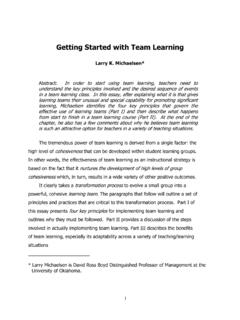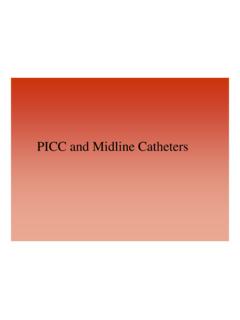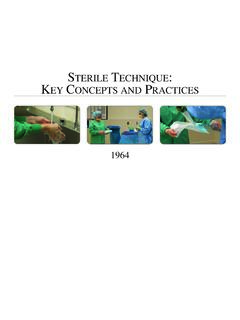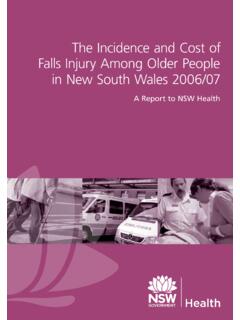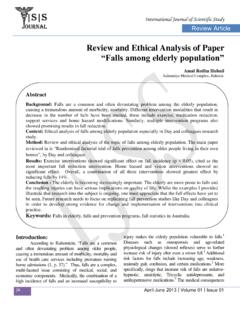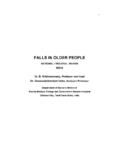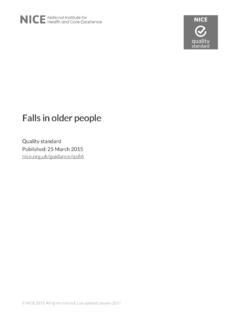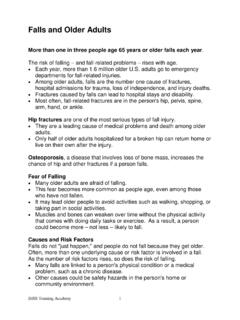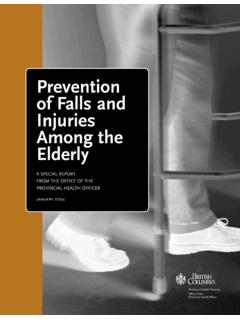Transcription of The impact of a home-based walking programme on falls in ...
1 Age and Ageing2015;44:377 383doi: The Author 2015. Published by Oxford University Press on behalf of the British Geriatrics rights reserved. For Permissions, please email: electronically 8 January 2015 The impact of a home-based walking programmeon falls in older people : the Easy Stepsrandomised controlled trialALEXANDERVOUKELATOS1,2,DAFNAMEROM3, CATHERINESHERRINGTON4,CHRISRISSEL5,ROBER TG. CUMMING5,STEPHENR. LORD61 Health Promotion Service, Sydney and Southwest Sydney Local Health District, Camperdown, NSW, Australia2 School of Public Health and Community Medicine, University of New South Wales, Sydney, NSW, Australia3 School of Science and Health, University of Western Sydney, Sydney, NSW, Australia4 The George Institute for Global Health, University of Sydney, Sydney, NSW, Australia5 Sydney School of Public Health, University of Sydney, Sydney, NSW, Australia6 Neuroscience Research Australia, University of New South Wales, Randwick, NSW, AustraliaAddress correspondence to: A.
2 Voukelatos. Tel: (+61) 2 9515 9079; Fax: (+61) 2 9515 9056. Email: is the most popular form of exercise in older people but the impact of walking on falls is unclear. Thisstudy investigated the impact of a 48-week walking programme on falls in older :three hundred and eighty-six physically inactive people aged 65+ years living in the community were randomisedinto an intervention or control group. The intervention group received a self-paced, 48-week walking programme that involvedthree mailed printed manuals and telephone coaching. Coinciding with the walking programme manual control group partici-pants received health information unrelated to falls .
3 Monthly falls calendars were used to monitor falls (primary outcome) over48 weeks. Secondary outcomes were self-reported quality of life, falls efficacy, exercise and walking levels. Mobility, leg strengthand choice stepping reaction time were measured in a sub-sample (n= 178) of :there was no difference in fall rates between the intervention and control groups in the follow-up period (IRR = ,95% CI: ). By the end of the study, intervention group participants spent significantly more time exercising ingeneral, and specifically walking for exercise (median versus h/week,P< ).Conclusion:ourfinding that a walking programme is ineffective in preventing falls supports previous research and questionsthe suitability of recommending walking as a fall prevention strategy for older people .
4 walking , however, increases physicalactivity levels in previously inactive older :accidental falls , older people , physical activity, walkingIntroductionInjuries resulting from falls are a leading cause of death andhospitalisation in people aged 65 years and over [1]. Fallscan also lead to poor quality of life, loss of independenceand nursing home admission [2]. Exercise has been identi-fied as an effective way of reducing the risk of falling, espe-cially in community-dwelling older people [3]. Fallprevention guidelines developed in the UK, USA andAustralia [4 6] refer to several studies which include awalking Otago Exercise Program is a home-based exerciseprogramme consisting of balance and strength exercises andwalking [7].
5 The exercise programme used in the study byRubensteinet al.[8] also consisted of strength and balancetraining together with endurance training including treadmilland indoor walking . Another study that effectively reducedfalls in older people used an exercise intervention that377 at University Library, University of Illinois at Chicago on August 5, 2015 from included Tai Chi, dance steps, weight transference, using re-sistance bands and fast walking [9]. Freibergeret al.[10] usedtwo similar interventions in their study; both interventionsincluded strength, balance and motor coordination training,however one intervention also included walking .
6 All of thesestudies showed that interventions that include a walking com-ponent are associated with reduced falls . However, as thesestudies had walking as one component of a multi-componentexercise intervention, it is difficult to evaluate the effective-ness of walking alone on are other studies that suggest walking is not aneffective intervention to prevent falls in older people . One ran-domised controlled trial found that a brisk- walking interven-tion increased the risk of falls compared with a no-exercisecontrol group in a sample of post-menopausal women, [11]and two other studies found that walking had no significanteffects on falls in older people [12, 13].
7 A meta-analysis of 54trials of exercise-based interventions found that greater fallsprevention effects were seen in studies that did not include awalking component in the intervention [14]. walking is a physical activity widely accepted by olderpeople that has many health benefits [15, 16]. In one survey, walking was identified by around 90% of older people as aneffective way of preventing falls [17]. However, the effect ofwalking on the risk of falling in older people remains inconclu-sive. This study investigated the impact of a 48-week, progres-sive walking programme on falls in inactive, community-dwellingpeople aged 65 years and study began in August 2009 and was completed inOctober 2012.
8 The study design was a parallel-group, rando-mised controlled trial with a 1:1 allocation ratio and a waitinglist control. Participants were recruited between August 2009and October 2011 (see Figure1). A detailed description ofthe study methods has been published elsewhere [18].The Sydney South West Area Health Service EthicsReview Committee (RPAH Zone) gave approval for thisstudy, and informed consent was obtained from all partici-pants prior to their participation. The study is registeredwith the Australian New Zealand Clinical Trials Registry(ACTRN12610000380099).Participan ts and recruitmentParticipants were recruited from community-dwelling peopleaged 65 years and over from the greater Sydney region,Australia.
9 Recruitment methods included paid advertise-ments and editorials in community newspapers, personaland professional referrals and sampling from the Australianelectoral be eligible for participation in the study, people had tobe: inactive ( <120 min of exercise per week); mobile ( to walk at least 50 m with minimal aid); and, able tocommunicate in English. people were excluded if they: had amedical condition precluding participation in the study ( , Parkinson s disease, stroke, debilitating arthritis,severe vision impairment); or, were participating in anotherresearch study [18].We estimated a sample size of 232 per group (N= 464)was required to detect a relative reduction in falls of 35%(RR = ) over 48 weeks.
10 This calculation was based on fallreduction rates from previous exercise-based fall preventiontrials, a fall rate of 33%, a significance level of and 80%power [3]. A sub-sample of 178 participants, based on detec-ting an absolute difference of 10% in choice step reaction time(CSRT), also received physical performance and blindingAfter baseline assessments (questionnaire) were completedparticipants were randomised into either the interventiongroup or control group by a research assistant using sequen-tially numbered sealed opaque envelopes. The randomisationscheme used randomised permuted blocks of size six andfour prepared by the chief investigator ( ).
